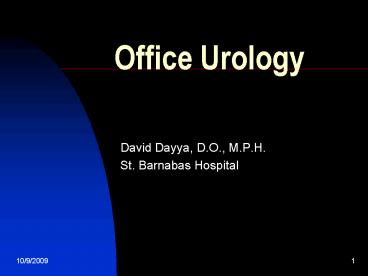Office Urology - PowerPoint PPT Presentation
1 / 23
Title:
Office Urology
Description:
Exercise. 3/10/09. 7. Hematuria DDX. Nonurinary tract causes. Neoplasms ... Kegel exercises, alpha agonists to increase smooth muscle tone at bladder outlet, ... – PowerPoint PPT presentation
Number of Views:705
Avg rating:3.0/5.0
Title: Office Urology
1
Office Urology
- David Dayya, D.O., M.P.H.
- St. Barnabas Hospital
2
Introduction
- Urological complaints are a common part of
clinical practice this discussion seeks to
elucidate these readily distinguishable and
treatable complaints. - What are they?
3
Topics of Discussion
- Hematuria
- Proteinuria
- Frequency
- Dysuria
- Incontinence
4
Hematuria
- Gross or microscopic?
- What are the associated symptoms if any?
( dysuria, frequency, urgency, foul malodorous
urine, abdominal pain, incontinence, dysuria,
incomplete voiding,Chemical irritants, urethral
or vaginal discharge, pruritis) - Is the hematuria real? (pseudohematuria)
- Office microscopic urine analysis?
5
Pseudohematuria DDX
- Food dyes, beets
- Rifampin
- Pyridium
- Urates
- Myoglobinuria
- Hemoglobinuria
- Menses
6
Hematuria DDX
- Infectious (Pyelonephritis, cystitis, urethritis,
prostatitis, septic emboli) - Acute febrile illness
- Nephrolithisasis (pelvic, ureteral, bladder)
- Glomerulonephritis ( PSGN, Membranoproliferative,
SLE, Crescenteric, Goodpastures, Rheumatoid,
Wegeners Glomerulomatosis) - Neoplasms ( Bladder, Renal, lymphoma, leukemia,
PCKD) - Trauma
- Coagulopathy
- Malignant hypertension or hypotension
- Vascular ( RAS, Renal vein thrombosis,
Thromboembolic, Sickle cell trait or disease) - Interstitial nephritis
- Analgesic nephropathy, CTX, anticoagulants,
- Exercise
7
Hematuria DDX
- Nonurinary tract causes
- Neoplasms of adjacent organs
- PID, Diverticulitis, Appendicitis, Endometritis,
Peritonitis - IBD
8
Proteinuria
- Quantity?
- Association with frequency or polyuria, dysuria,
frequency, urgency, etc.?
9
Benign Proteinuria
- Fever
- Exercise
- Orthostasis
- Contrast dye
10
Non Nephrotic range proteinuria
- Pyelonephritis
- TB
- Interstitial Nephritis
- ATN
- Nephrolithiasis
- Malignant Hypertension
- Urinary Tract neoplasms
- PCKD
- Trauma
- Hereditary nephritis
- Glomerular Nephritis
11
Nephrotic range proteinuria
- Minimal Change disease
- Glomerulonephritis
- Glomerulosclerosis
- D.M.
- Amyloidosis
- Neoplasms ( Mets, myeloma, leukemia, lymphoma)
- Sarcoidosis
- Thyroid diseases (graves,myxedema)
- Sickle cell disease
12
Nephrotic range proteinuria
- Toxins,drugs, vaccines
- Allergens
- Systemic or other serious infections
- CHF
- Valvular/Structural disease causing right sided
congestion - Preeclampsia
- Morbid Obesity
- Renal vein/Vena cava thrombosis
- Alports syndrome
13
Dysuria
- UTI
- STD (Urethritis)
- Vulvovaginitis/Atrophic vaginitis
- Prostatitis
- Mechanical/Chemical irritation
- Allergic reaction
- Bladder outflow obstruction
- Tumor
- Sexual Abuse
14
Laboratory Evaluation
- UA (repeat), UCS
- Office Urine Microscopy
- 24 hour Urine collection
- Post void urinary catheterization
- CBC
- Bun/Cr
- CPK
- Albumin, Total Protein, LDH, Bilirubin (D/I)
- PSA/PAP
- Urine eosinophils
- ANA, ESR, RF, C3, C4, CH50
15
Special Testing
- Renal Ultrasound
- Renal Scan
- IVU, Voiding cystourethrogram
- CT
- Angiography
- Cystoscopy
- Biopsy
16
Incontinence
- Involuntary loss of urine so severe as to have
social and hygienic consequences - 30 of the eldery
- 50 of N.H. patients
- Stigma
17
Incontinence
- HP including endocrinology, neurological,
malignancy, surgery, parity, meds, pattern of
voiding, bowel habits, sexual function,
menopausal, voiding record, Neurological exam,
mini mental status exam, abdominal exam, valsalva
maneuver, rectal exam
18
Incontinence
- Stress Incontinence
- Urge Incontinence
- Overflow incontinence
- Functional Incontinence
19
Stress incontinence
- Urine loss during activities that increase
intra-abdominal pressure caused when
intravescicular pressure exceeds urethral
sphincter pressure - Kegel exercises, alpha agonists to increase
smooth muscle tone at bladder outlet, Tricyclic
antidepressants decrease detrusor activity
contractility and increase outlet resistance,
estrogen improves bladder tone - Surgery for women with pelvic prolapse including
bladder neck suspension and urethral sling
procedures.
20
Urge Incontinence
- Detrusor muscle irritability resulting in sudden
urge that exceeds ability of urethral sphincter
to maintain control resulting in leakage of
urine. - Chronic cystitis, infiltrative diseases, CNS
lesions - Bladder training, direct acting smooth muscle
relaxants, anticholinergics, calcium antagonists,
ERT
21
Overflow incontinence
- The bladder is unable to empty normally resulting
in the bladder becoming over distended and
resulting in urine loss. - Most common bladder outlet obstruction, BPH
- Crede maneuver or valsalva, alpha blockers to
reduce sphincter tone, cholinergic agents to
improve detrusor contractility - Finasteride
- TURP,TUIP, TULIP
22
Functional incontinence
- Non-urinary tract causes of incontinence
23
DRIP
- Reversible incontinence
- Delirium, Dementia, Depression
- Restricted Mobility, Retention
- Infection, inflammation (atrophic vaginitis),
impaction - Pharmaceuticals, Polyuria (glucosuria, CHF)

